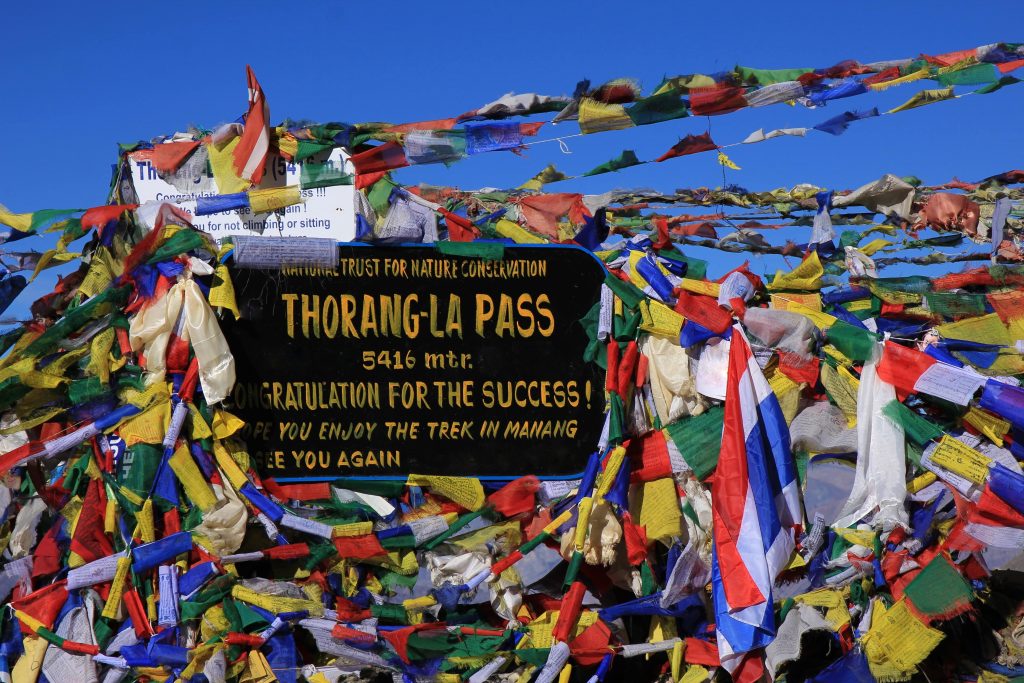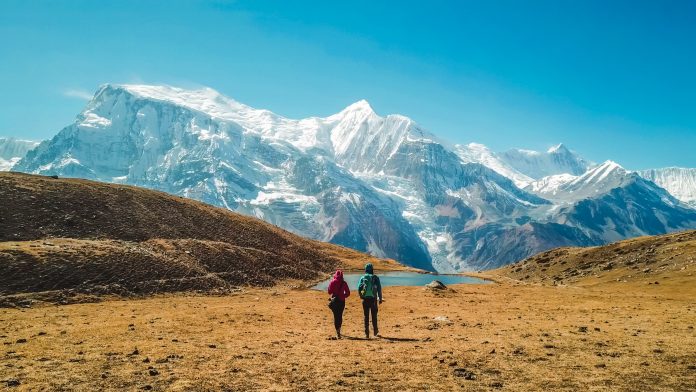The Annapurna circuit trek and the Annapurna Base Camp trek are fast gaining traction as the preferred Himalayan treks, competing with the EBC trek. The Annapurna Circuit trek, as the name suggests, is in the Annapurna region. The Annapurna is the tenth highest peak in the world, with its summit at 8,091m (26,545 ft). The Annapurna circuit trek is about circumventing this peak and, of course, the entire Annapurna region.

One major highlight of this trek is the diverse landscape that it has. You will get to see the grasslands, the paddy fields, the subtropical forests, waterfalls, and snow-covered peaks- all in one single trek. In addition, if you choose to go on the spring trek, you’ll get to see the Himalayan Blue Poppy- the Queen of the Himalayas, too (if you are lucky enough).

We told you so much because the Annapurna Circuit Trek is moderate and less difficult than the EBC trek. Therefore, with some basic training, you can go for the ACT.
In this blog, however, we will talk about the difficulty of the Annapurna Circuit Trek or the ACT. The difficulty of any trek depends on the altitude and the weather. You see, most of the Himalayan treks are long. Let us take the case of ACT here, which is a 16-day long trek and involves considerable walking. If you haven’t trained adequately, you may feel tired or have to take long breaks, which would kill your experience. However, if you have done some kind of physical training, then you’ll not have to worry at all!
The Difficulty Level of the Annapurna Circuit Trek
As we mentioned before, this trek is moderately difficult and will take you on some magical adventures. To talk about what makes the trek moderately difficult, though, let us look at the relevant bits:
1. The Trek Duration
The Annapurna Trek duration with TrekNomads is 16 days. It involves considerable walking and a couple of drives too.
2. The Distance to be traveled
The total distance to be covered in the trek is between 160km to 230km, depending on where you begin or end the journey. In most cases, the journey starts and ends in Kathmandu. While trekking, you will walk for roughly 5 to 6 hours daily and cover a distance of approximately 12-15km daily. Hence, you better train adequately for walking up to these distances. Of course, there will be intermittent breaks taken to rest but let’s not rely on them to define our trekking experience.
You may find the lower regions easier to trek/climb than the higher ones. This is because the more elevated areas have steeper and harsher terrain.
3. Altitude Sickness
“Oh! Altitude Sickness, why do you come up?” Just tried to go all Shakespeare here but unfortunately couldn’t. Anyway, Altitude Sickness is super unfortunate, but it does happen. It is very common for most Himalayan treks since they all involve trekking at high altitudes. It occurs because of the reduced oxygen levels at higher altitudes, mostly beyond 4000m.
Some common symptoms of Altitude Sickness involve:
- Headache
- Nausea
- Vomiting
- Dizziness
- Shortness of breath
- Difficulty in sleeping
- Loss of appetite
- Diarrhoea
It is important to note that if you feel any of the symptoms mentioned above, inform your trekking guide immediately. Please do not brave any of these as they can worsen. We at TrekNomads take extreme care and precautions to avoid its onset for our fellow travellers and carry a first aid kit for the same reason. However, if you ever feel like something isn’t right – please inform the trek leader.
4. Food
The food is not typically an issue till you are someone who can live only on junk or western food. You will get some sumptuous servings of dal, bhat, achar, curry, and multiple side dishes- all of which will make you fall in love with Nepali cuisine.
For the latter, i.e., the diet food – don’t even think of living off of salad! You’ll need much more energy on that, so if you are extremely conscious about your caloric intake, I suggest you sit with your dietician and get your diet right.
Well, that was more or less about the difficulty level. It is a moderate difficulty trek after all; however difficult it can be 🙂

However, we still made sure to make a list of 7 things you should be prepared for before taking the Annapurna Circuit Trek.
7 things to know to make your Moderate Difficulty Trek Easy Peasy Lemon Squeezy!
ACT is one of the best treks if you are looking at exploring the beauty of Nepal in general too. We just had to give this extra information- it has nothing to do with this blog.
So, coming to the point, we told you that the ACT trek is of moderate difficulty; the following 7 points will tell you how to make your experience even better:
1. Plan the Time
In another one of our blogs, we talked about which would be the best season to trek. The consensus was that Autumn and Spring are the best, with Spring being the quieter. However, Autumn has cheaper flights and more affordable hotels. Summers, Monsoons, and Winters have pluses, but there are enough negatives to deter most. You can read more about it in detail in the said blog.
2. Pack Smartly
You may or may not choose to take a porter, but in any case, ensure you do not carry unnecessary items. In another one of our blogs, we have created a detailed list of things you need to pack for the Annapurna Circuit Trek. We suggest you stick to that.
3. Don’t underestimate the power of High Altitude.
Altitude sickness afflicts people even at 2,500m above sea level. While the usual is 4,000 m above sea level, still you never know. Hence, it is always a good idea to take precautions and drink a lot of water. Keeping yourself hydrated will most likely prevent nausea. Also, carry some light but protein-rich food like chocolates, peanuts, or the likes in your backpack. That will help too.
4. Wear your clothes properly
When we say wear four layers, we mean four layers of clothing. It doesn’t mean three or two because you are strong. Also, the Annapurna region is known for sudden weather changes. It can get slightly colder than when you started in the morning, so you better be dressed for that. Also, please wear your sun hat and sunglasses- you’ll need them because, unlike the plains, the sunlight here is direct and very sharp.
5. Eat Well but not too much.
Simply put, you will love the dal, bhat, and the other local delicacies served to you. Also, it is perfectly suited for the trek since the people of this region have to do that a lot. You will also be served garlic soup- a local remedy for Altitude sickness. It is delicious anyway, so try it. Make sure you have your fill because you will need that energy. Also, stock up for the trek in Kathmandu itself because the walking sometimes gets you hungry, and you wouldn’t want to stop because of the energy loss.
6. Keep Water Purifying tablets/Water bottles along.
Nothing like it if you can bring and keep your water bottles. That way, you would have easy access to water most of the time. Also, plastic water bottles ruin the natural ecosystem because most of these regions have no waste disposal system; hence, the bottle you dispose of will be there forever. We advise against tap water, though, as it may not be safe enough for your immune systems. Purification tablets can come in handy here because they will make tap water fit for drinking.
7. Prepare yourself for the ThorongLa Pass.
Thorong La makes for probably the toughest part of the Annapurna Circuit Trek. You have to wake up before sunrise (around 1 to 2am) and head over narrow ridges in thick snow cover. Then you have to climb continuously for hours, but none of it is something that you cannot prepare for. Wear enough warm clothes and train (workout) for this excursion well in advance. That should do.

So dear Nomads, that was it from our side, and we hope you had a good time reading it and imagining your Annapurna Circuit Trek. By the way, you can also check and decide between Annapurna Base Camp Trek and Annapurna Circuit Trek. The details can be accessed here.
PS: Our trek to Annapurna Circuit and Annapurna base camp will start from 3rd Sept. You can book your slots now.
